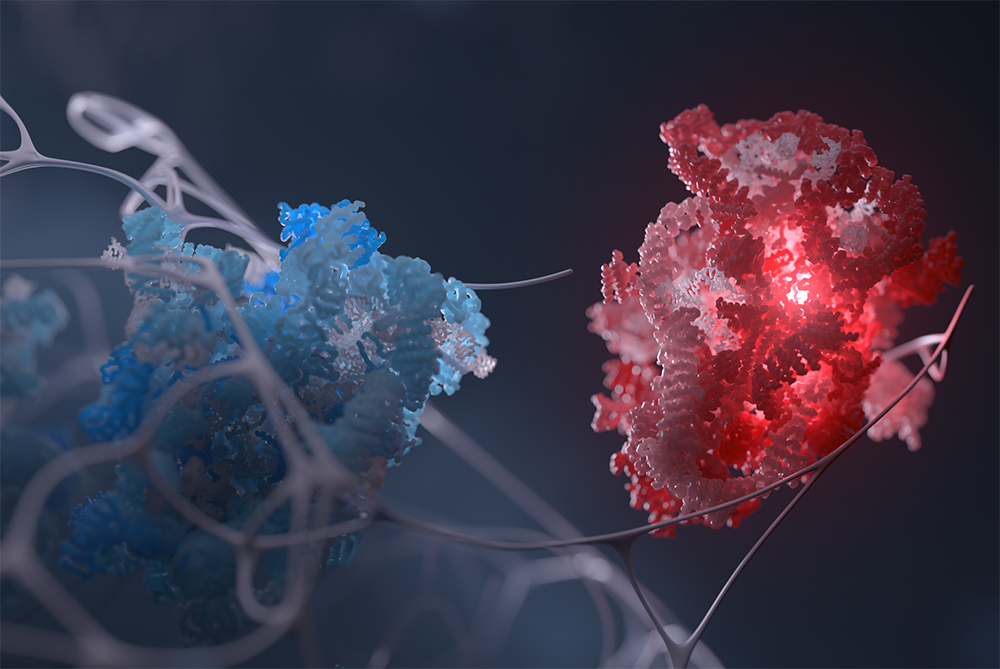Illustration of pre-ribosomal particles moving through the nucleolus, represented by the gray mesh. (Credit: Phospho biomedical animation)
Ribosomes carry out the cell’s most essential function—translating genetic information into proteins. But even though scientists understand much about how these protein generators are formed, their birth remained shrouded in mystery: no method existed for peering inside the cell’s dense nucleolus, where ribosomal RNA (rRNA) gives rise to nascent ribosomes.
Now, a new study breaks open that black box. The paper, published in Nature—a collaboration between Rockefeller, Princeton University, and the Université libre de Bruxelles—demonstrates not just how rRNA creates ribosomes, but also how rRNA lays down a blueprint for the nucleolus—and that revamping the shape and structure of the nucleolus can be as straightforward as biochemically altering that blueprint.
“We can now design and manipulate the architecture of an entire organelle,” says Sebastian Klinge, head of the Laboratory of Protein and Nucleic Acid Chemistry. “This brings us closer to bridging the gap between atomic structure and cellular organization—and to uncovering the precise molecular mechanisms that govern organelles’ forms and functions.”
Birth of a ribosome
The nucleolus was one of the first organelles ever observed. It’s hard to miss. A dark cluster inside the nucleus, this is where rRNA is transcribed, processed, and assembled into ribosomal subunits, which are then exported to the cytoplasm. A closer look at the nucleolus reveals three nested compartments: the innermost fibrillar centre (FC), the middle dense fibrillar component (DFC), and the outer granular component (GC).
Scientists suspected that this specific architecture was related to ribosome biogenesis, but how these layers formed and interacted with rRNA and ribosomes was unclear. It was a question with particular significance for Klinge—whose lab focuses on the molecular mechanisms that govern ribosome assembly—and also for Rockefeller. Ribosomes were discovered here on campus in 1955, and Rockefeller labs have since played an outsize role in RNA research.
The role of rRNA
For the study, researchers from Princeton and Brussels used a cutting-edge method to tag freshly made rRNA and watch how it moves and matures inside cells. They discovered that the layered structure of the nucleolus is shaped by the movement of rRNA itself. As rRNA is produced, it travels through each layer of the nucleolus in a specific order. If any step is missed or delayed, the rRNA gets stuck and the structure of the nucleolus breaks down. This demonstrated that each layer of the nucleolus (especially the DFC) acts as a quality-control checkpoint to make sure that ribosomes are ultimately built correctly.
But the results raised a tantalizing possibility. If the structure of the nucleolus is so inextricably tied to ribosome production, could it be that the nucleolus is built around the same process that it enables—shaped and sustained by the steps of ribosome production itself?
To find out, the team turned to Klinge for help engineering synthetic nucleoli and directly testing how changes to rRNA impact the architecture of the nucleolus. Klinge’s lab provided DNA plasmids designed to manipulate the structure and progression of human ribosome assembly, based on prior work that the lab had published in 2021. His contribution allowed the team to tweak rRNA sequences and alter the pathway underlying ribosome biogenesis.
With Klinge’s synthetic nucleoli, the researchers discovered that they could manipulate the structure of the nucleolus. By introducing rRNA mutations that block the formation of ribosome assembly intermediates, the researchers succeed in inverting the entire organelle—taking the FC and DFC, normally nested at the core, and casting them out to the periphery. This inversion disrupted the normal release of rRNA, and could only be reversed by introducing other mutations. Based on their findings, the researchers also developed a biophysical model explaining how changes in rRNA intermediates influence tension between nucleolar layers.
“The design of an artificial nucleolus based on a DNA plasmid my lab had previously used for functional studies provided the starting point to link pre-ribosomal RNA sequence information to the multi-layered architecture of the human nucleolus at the micrometer scale,” Klinge explains. “By redesigning this plasmid, we were able to show that the correct formation of a particular ribosome assembly intermediate dictates the architecture of the human nucleolus.”
Together, these experiments establish that the nucleolus is not merely a staging ground for ribosome production, but a dynamic, RNA-programmed organelle.
Next, Klinge and colleagues hope to explore how ribosome assembly intermediates move through and exit the multilayered structure of the nucleolus, continuing to piece together the mystery of how one of life’s most fundamental machines comes together. “It may soon be possible to address this mechanistically at a near-atomic level,” Klinge says.
